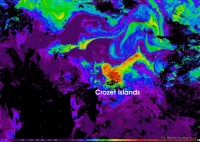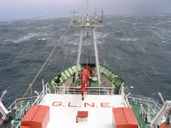Transit to Crozet 4/12/2005 – 5/12/2005
Time to talk a little of the science! Benthic Crozet will
study the sea-floor dwelling community to the north and
south of the Crozet Islands at about 4000 m depth. Why?
The deep-sea food chain relies on food falling from surface
waters. Phytoplankton are microscopic single celled algae
that photosynthesise at the surface of the ocean. When they
die, their remains sink through the water and can reach
the sea floor thus providing a food source to deep-sea animals.
Phytoplankton, like all plants, need nutrients such as nitrogen
and phosphorous to grow. In this part of the ocean, these
nutrients are relatively plentiful, but one important element
is missing, or is at least very scarce! Iron (Fe, is the
chemical symbol). For most of the year, there is little
photosynthesis going on because most of the essential nutrients
are "trapped" in deep waters. However, from October
onwards, oceanic circulation coupled with atmospheric conditions
leads to deep nutrient-rich waters being driven to the surface
(this is called "upwelling") to the north of Crozet.
It seems as if these waters are rich in iron, because phytoplankton
take off or “bloom”. To the south of Crozet,
there is no upwelling of deep water and so, no bloom.
 |
The
Figure
shows some satellite data for chlorophyll abundance
(a marker of phytopklankton) at the sea surface (to
a few metres depth). Deeper reds are higher values.
These data are a composite for 28th November –
4th December 2005 (courtesy of Dr. Tim Smyth, Remote
Sensing Group at Plymouth Marine Laboratories). There
is a clear and pretty intense bloom north of Crozet.
(Click on picture
for a larger version!) |
The organisms living at the deep-sea floor to
the north of the island are likely to get a seasonal pulse
of material arriving from this bloom, whereas to the south,
they will have no such luck! This contrast is the key to our
work!
Measuring iron in sea water is important, but
very difficult, because there is very little of it (0.000000005
grams per litre, or less!), therefore there is great risk
of contamination. So we have to collect water well away from
the ship (rusty hull!). Research activity started this morning.
The "fish", an instrument that is used to collect
clean water, was deployed at sea. This equipment helps scientists
to sample sea water continuously. Hélène, Will
and Hugh are focusing their analysis on iron. After 3 attempts,
and some minor modifications (1. adding weights at the front
of the fish, 2. making a system to prevent crushing the pipe
that sucks the water) the fish was stabilized at 2 meters
underwater and 5 meters away from the ship. Now samples suitable
for iron analysis can be collected and piped directly to the
"clean lab" (a part of the ship's labs that contamination
is kept to a minimum). More on that later!
The “fish” an instrument used
to collect seawater for the measurement of iron (and other trace
metals)
(Click on pictures for a larger version!)
 |